Ba Lang An is a cape created from lava deposits that gradually flowed down towards the sea. Especially in Ba Lang An now, there is still a volcanic crater close to the shore, every day it lies still, opening its mouth to swallow the ocean waves and attracting tourists from all over to admire.
NEAREST PLACE TO HOANG SA
From Quang Ngai City, go to Ba Lang An scenic spot (in Phu Quy village, Binh Chau commune, Binh Son district, Quang Ngai) about 30 km. Many people also know Ba Lang An by another name, Ba Tan Gan cape. The reason why it is called Ba Lang An is because this place is named after 3 coastal villages: An Hai (Binh Chau commune), An Vinh and An Ky (Tinh Ky commune, Quang Ngai City).
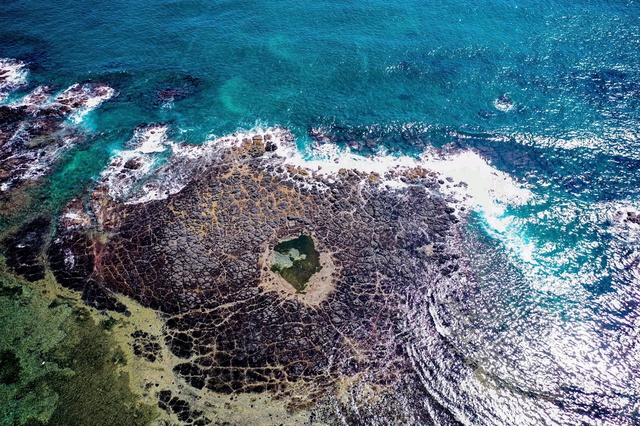
Volcanic crater near the coast of Ba Lang An
PHOTO: HAI PHONG
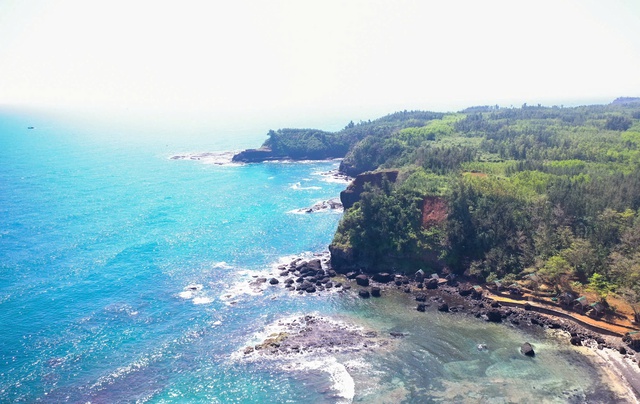
Majestic and poetic scenery in Ba Lang An
PHOTO: HAI PHONG
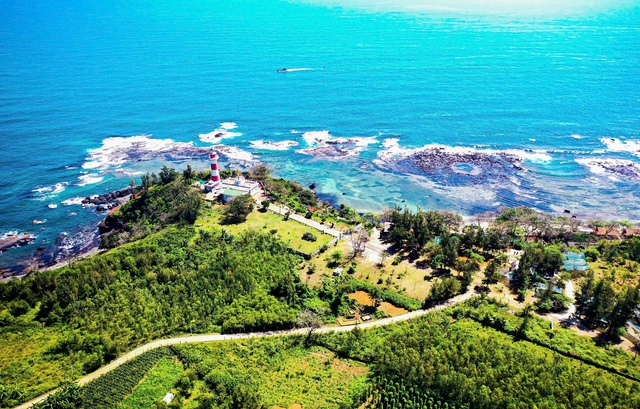
Ba Lang An Cape, where there is a lighthouse close to the coast
PHOTO: HAI PHONG
People from these 3 fishing villages around the 17th century went to Ly Son to reclaim land and establish villages. Books also record that 8 people from An Hai village went to Ly Son to establish An Hai village; 7 people from An Vinh village went to Ly Son to establish An Vinh village...
Standing at Ba Lang An, you can clearly see Ly Son Island with 3 volcanoes standing tall in the middle of the ocean. Few people know that Ba Lang An Cape is determined to be the closest mainland location to the Hoang Sa archipelago, about 135 nautical miles. There is also a cliff there that is formed by sediments from volcanic activity.
When visiting Ly Son Island, tourists are overwhelmed by the towering cliffs, and the feeling is the same when coming to the majestic stone pillars and cliffs at Ba Lang An Cape. The cape hears waves crashing all day long. Waves from the open sea to the shore, caressing each jet-black rock and then splashing foam up to the sky.
That long, winding black rock bank along the coast, forming coves, caves and cliffs… never gets boring to look at.
However, when coming to Ba Lang An, perhaps the most interesting thing is the crater located close to the shore. It is about 30 m2 wide, as if it is sleeping. When the tide rises, this crater seems to suck in and release waves, puffing like a giant mouth sipping and eating each wave. When the tide recedes, the crater is exposed like a heavenly pan, containing within it a small population of snails, moss, fish... living together.
Above this dormant volcano, there are layers of black rocks like hundreds of plates arranged evenly around. The cracks on the crater are like dry, cracked skin, traces of millions of years ago when the volcano was still awake, erupting from its belly layer upon layer of lava.
Around the crater, there are also basalt fields, ballast columns, and lava rocks that are extremely strange, bringing a charming, magical, and mysterious beauty. In addition, in this area, there are also red rocks that look like laterite. According to research by geologists, this intact crater was formed 6 - 11 million years ago.
POETIC ROCK DISC ON THE Crest Of The Waves
The day we were in Ba Lang An, we rented a motorboat and sailed along the coast of Binh Chau commune. The sunset scenery here was like a painting, shimmering and majestic beyond words. Our boat passed by Bai Den, which the locals often call Bai Mo.
Bai Mo has jet-black, dreamy rocks in the open space, absorbing the spiritual energy of heaven and earth, lying and listening to the sea sing all year round.
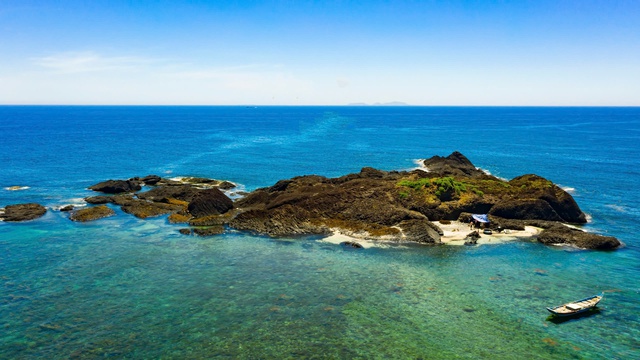
Hon Nhan scenery at noon
PHOTO: HAI PHONG
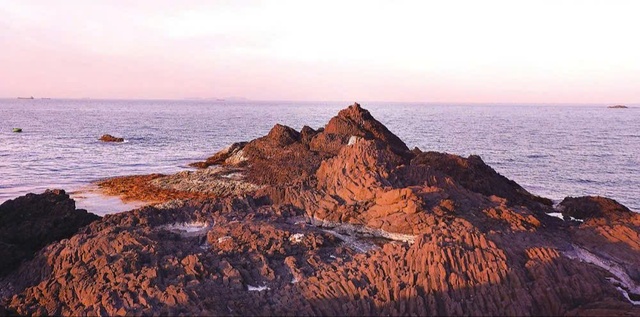
Hon Nhan at sunset
PHOTO: HUU NGHIA
Turning the boat towards the sea for less than 15 minutes, we were overwhelmed by a small rocky desert island located less than 1,000 meters from the shore. The sunset here is as brilliant as a European fairy tale. That is Hon Nhan, the locals say that because the sea terns often fly back and land here, it is called Hon Nhan.
Finding a place to anchor the boat, a small cove to the northeast, we went to this strange rocky island. That day, the terns did not return, but hundreds, even thousands of stone crabs clung to each ledge in flocks.
Walking around the rocky island, we witnessed each stone pillar and stone plate arranged layer upon layer, not unlike the stone plate reef in Phu Yen . A tourist from Da Lat that day who went with us was amazed by the natural beauty of Hon Nhan.
According to the Department of Culture, Sports and Tourism of Quang Ngai province, on October 25, 1993, the People's Committee of Quang Ngai province issued a decision on the protection of the historical - cultural relic and scenic spot of Ba Lang An. There is also a lighthouse (called Ba Lang An lighthouse) built by the French for the first time in the 80s of the 19th century. In 1982, this lighthouse was restored and built with 80 steps, 36.4 m high. Standing on the lighthouse, you can see about 17 nautical miles out to sea.
According to Mr. Nguyen Xuan Nam, Institute of Geosciences and Mineral Resources, volcanic activities have created spectacular landscapes in Quang Ngai: Volcanic craters, columnar basalt cliffs, river terraces, sea terraces, and beautiful beaches. In addition, there is a terrain that reflects the interaction between the continent and the sea. Mountain ranges from the continent reaching out to the sea create beautiful, interesting landscapes, including Ba Lang An Cape and many other coastal landscapes of Quang Ngai. (continued)
Source: https://thanhnien.vn/nhung-tuyet-tac-thien-nhien-ba-lang-an-noi-da-nam-nghe-bien-hat-185250526222138388.htm




![[Photo] Vietnamese and Hungarian leaders attend the opening of the exhibition by photographer Bozoky Dezso](https://vphoto.vietnam.vn/thumb/1200x675/vietnam/resource/IMAGE/2025/5/28/b478be84f13042aebc74e077c4756e4b)
![[Photo] Prime Minister Pham Minh Chinh receives a bipartisan delegation of US House of Representatives](https://vphoto.vietnam.vn/thumb/1200x675/vietnam/resource/IMAGE/2025/5/28/468e61546b664d3f98dc75f6a3c2c880)
![[Photo] General Secretary To Lam works with the Central Policy and Strategy Committee](https://vphoto.vietnam.vn/thumb/1200x675/vietnam/resource/IMAGE/2025/5/28/7b31a656d8a148d4b7e7ca66463a6894)
![[Photo] 12th grade students say goodbye at the closing ceremony, preparing to embark on a new journey](https://vphoto.vietnam.vn/thumb/1200x675/vietnam/resource/IMAGE/2025/5/28/42ac3d300d214e7b8db4a03feeed3f6a)
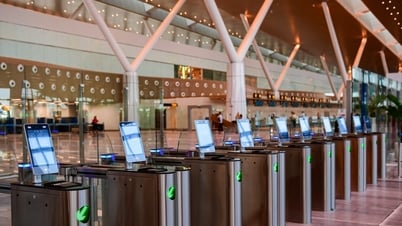




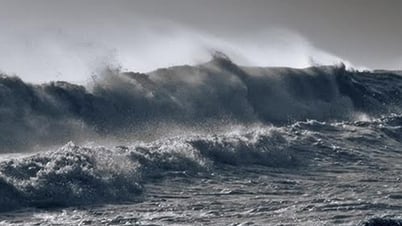


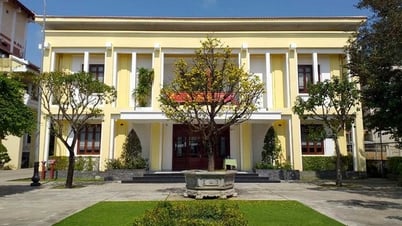





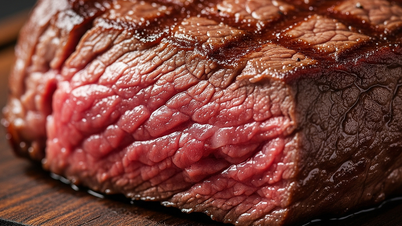























































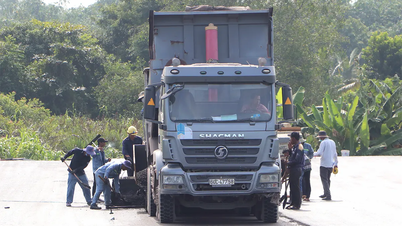

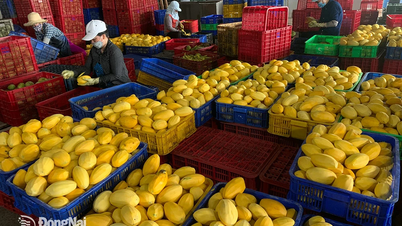

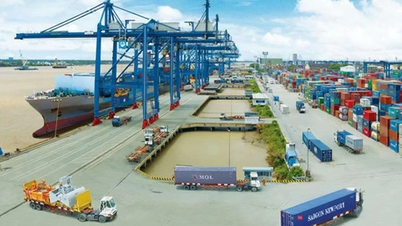








Comment (0)